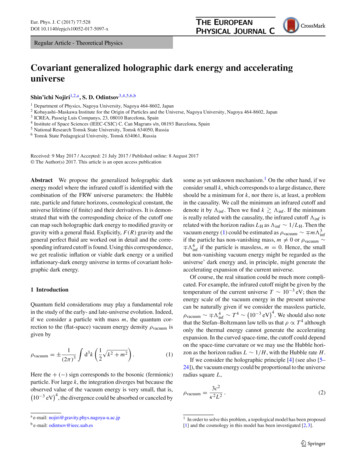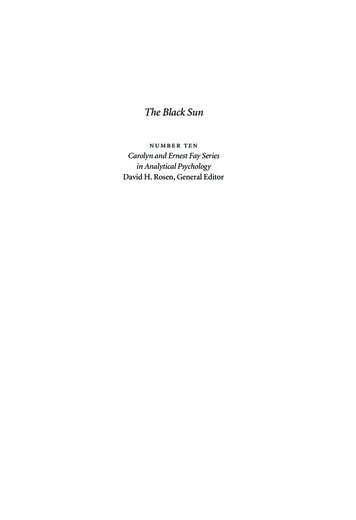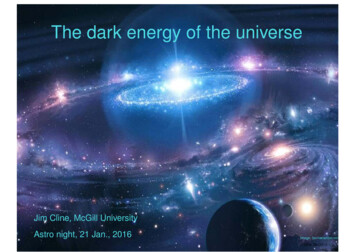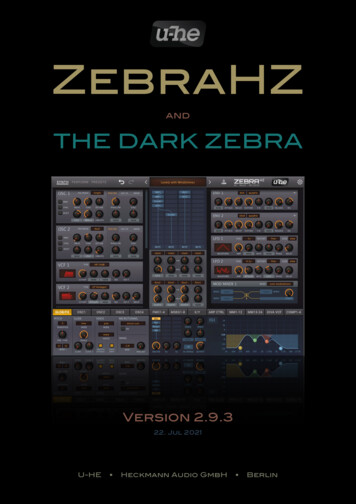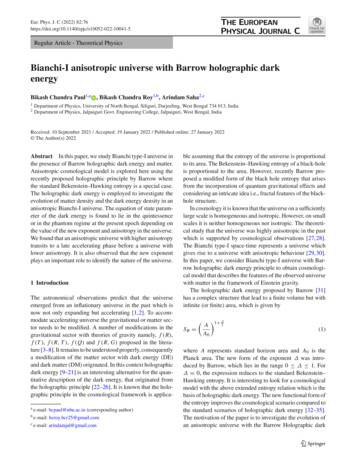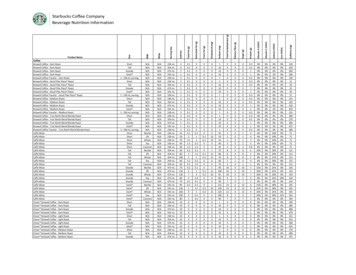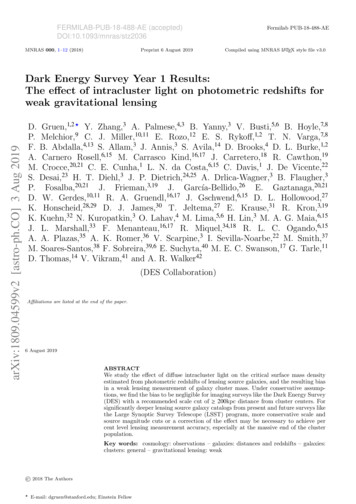
Transcription
FERMILAB-PUB-18-488-AE (accepted)DOI:10.1093/mnras/stz2036MNRAS 000, 1–12 (2018)Preprint 6 August 2019Fermilab PUB-18-488-AECompiled using MNRAS LATEX style file v3.0arXiv:1809.04599v2 [astro-ph.CO] 3 Aug 2019Dark Energy Survey Year 1 Results:The effect of intracluster light on photometric redshifts forweak gravitational lensingD. Gruen,1,2? Y. Zhang,3 A. Palmese,4,3 B. Yanny,3 V. Busti,5,6 B. Hoyle,7,8P. Melchior,9 C. J. Miller,10,11 E. Rozo,12 E. S. Rykoff,1,2 T. N. Varga,7,8F. B. Abdalla,4,13 S. Allam,3 J. Annis,3 S. Avila,14 D. Brooks,4 D. L. Burke,1,2A. Carnero Rosell,6,15 M. Carrasco Kind,16,17 J. Carretero,18 R. Cawthon,19M. Crocce,20,21 C. E. Cunha,1 L. N. da Costa,6,15 C. Davis,1 J. De Vicente,22S. Desai,23 H. T. Diehl,3 J. P. Dietrich,24,25 A. Drlica-Wagner,3 B. Flaugher,3P. Fosalba,20,21 J. Frieman,3,19 J. Garcı́a-Bellido,26 E. Gaztanaga,20,21D. W. Gerdes,10,11 R. A. Gruendl,16,17 J. Gschwend,6,15 D. L. Hollowood,27K. Honscheid,28,29 D. J. James,30 T. Jeltema,27 E. Krause,31 R. Kron,3,19K. Kuehn,32 N. Kuropatkin,3 O. Lahav,4 M. Lima,5,6 H. Lin,3 M. A. G. Maia,6,15J. L. Marshall,33 F. Menanteau,16,17 R. Miquel,34,18 R. L. C. Ogando,6,15A. A. Plazas,35 A. K. Romer,36 V. Scarpine,3 I. Sevilla-Noarbe,22 M. Smith,37M. Soares-Santos,38 F. Sobreira,39,6 E. Suchyta,40 M. E. C. Swanson,17 G. Tarle,11D. Thomas,14 V. Vikram,41 and A. R. Walker42(DES Collaboration)Affiliations are listed at the end of the paper.6 August 2019ABSTRACTWe study the effect of diffuse intracluster light on the critical surface mass densityestimated from photometric redshifts of lensing source galaxies, and the resulting biasin a weak lensing measurement of galaxy cluster mass. Under conservative assumptions, we find the bias to be negligible for imaging surveys like the Dark Energy Survey(DES) with a recommended scale cut of 200kpc distance from cluster centers. Forsignificantly deeper lensing source galaxy catalogs from present and future surveys likethe Large Synoptic Survey Telescope (LSST) program, more conservative scale andsource magnitude cuts or a correction of the effect may be necessary to achieve percent level lensing measurement accuracy, especially at the massive end of the clusterpopulation.Key words: cosmology: observations – galaxies: distances and redshifts – galaxies:clusters: general – gravitational lensing: weak 2018 The Authors?E-mail: dgruen@stanford.edu; Einstein Fellow
21Gruen et al.INTRODUCTIONWeak lensing mass calibration is a key to achieving the fullpotential of galaxy cluster cosmology (for a discussion, seee.g. von der Linden et al. 2014). Numerous lensing studies have provided cluster mass estimates over the last years(e.g. Gruen et al. 2014; von der Linden et al. 2014; Hoekstra et al. 2015; Okabe & Smith 2016; Simet et al. 2017;Melchior et al. 2017; Dietrich et al. 2017a; McClintock et al.2018). The statistical power of such analyses is continuouslygrowing with precise lensing source catalogs around largecluster samples coming from DES,1 , HSC,2 and KiDS3 , andfuture Euclid,4 LSST,5 or WFIRST6 data. This improvement in statistics requires an equivalent push for reducingsystematic uncertainties in measurement and modeling oflensing signals. State-of-the-art studies account for systematic effects such as deviations of the assumed model of thecluster matter density profile from the truth (e.g. Becker &Kravtsov 2011), systematics in lensing source catalogs (e.g.Zuntz et al. 2017), excess contamination of the lensing sourcecatalog with cluster member galaxies (e.g. Melchior et al.2017; Medezinski et al. 2017), and biases and calibrationuncertainties in lensing source photometric redshifts inherent to the algorithms used for estimating them (e.g. Gruen& Brimioulle 2016; Hoyle et al. 2017). In recent studies, eachof these effects cause uncertainty on cluster mass at the levelof one to a few per cent (e.g. Melchior et al. 2017).In this paper, we investigate another effect on redshiftestimates of weak lensing sources – the bias due to contamination of source photometry from diffuse intracluster light(ICL). In our ICL model, we consider light from the centralgalaxy and from unbound stars in the cluster potential (seeexamples of studies or reviews in Zwicky 1951, 1952; Gonzalez et al. 2005; Zibetti et al. 2005; Mihos 2015; Montes &Trujillo 2018; Kravtsov et al. 2018) as well as the light offaint member galaxies below the survey selection threshold.The diffuse light biases the flux and color measurements oflensing source galaxies, and causes a systematic change inphotometric estimates of their redshift distributions. Amongother effects, the spectral energy distribution (SED) of passive stellar populations at the cluster redshift introduces amild cluster rest-frame D4000 break to the observed SED ofthe lensing source galaxy. These changes in flux and color affect the redshift assigned, especially for star-forming galaxieswith weaker break features.Careful analysis of color-magnitude space could be usedto select galaxies less susceptible to these effects, and composite models for blended galaxies could in principle fully account for them. Given the complexity and algorithm dependence of source photometry and redshift estimation, we donot aim to provide a prescription for correcting ICL photo-zcontamination in this paper. Our goal is rather to evaluateapproximately and, if possible, conservatively, what amplitude of bias we expect and identify the regimes in which itcan be rg/https://wfirst.gsfc.nasa.gov/In section 2, we describe our model for the surfacebrightness of intracluster light, using the results of Zhang(2018). In section 3, we derive our estimate for how diffuseintracluster light of given surface brightness biases the lensing amplitude predicted from photometric redshifts, basedon Gruen & Brimioulle (2016). Section 4 combines thesetwo components of the model to estimate the bias in lensingexcess density profiles in a typical current (DES-like) and future (LSST-like) survey, as a function of cluster redshift andseparation from the cluster center. We conclude the studyin section 5.Estimates of a quantity q are denoted as q̂.All magnitudes given in the u?g 0r 0i 0 z 0 bands are inCFHT/Megacam filters7 u.MP9301, g.MP9401, r.MP9601,i.MP9701, z.MP9801 and AB units until otherwise noted.Surface brightnesses are given in nJy arcsec 2 units. Thesecan be converted to counts per arcsec2 at a magnitude zeropoint of 30 with a conversion factor of 3.63 nJy per count,i.e. 3.63 nJy arcsec 2 correspond to 30 mag arcsec 2 . Cosmological distances for the scaling of lensing signal amplitudesare calculated in a flat Λ cold dark matter cosmology withΩm,0 0.27, and masses are expressed assuming a Hubbleconstant H0 70km s 1 Mpc 1 .2INTRACLUSTER LIGHT MODELThe goal of this section is to derive a model for the surfacebrightness of ICL. We describe it as a function of clustermass, cluster redshift, and projected physical distance fromthe cluster center.The distribution of ICL is a debated topic in the literature. It is believed that the ICL contains a significantamount of stellar mass (Behroozi et al. 2013; Contini et al.2014; Pillepich et al. 2018), comparable to that of clustercentral galaxies or the rest of the cluster galaxies. However,measurements of ICL in various samples (Zibetti et al. 2005;Gonzalez et al. 2005; Krick et al. 2006; Toledo et al. 2011;Burke et al. 2012; Gonzalez et al. 2013; Montes & Trujillo2014; DeMaio et al. 2015) do not necessarily find agreementon such a massive component, possibly due to methodological difference (such as differences in filter bands, or surfacebrightness thresholds and other criteria used to distinguishICL from galaxies, see e.g. Morishita et al. 2017, Montes &Trujillo 2018 and the discussion in the latter), cluster-tocluster variations (e.g., Krick & Bernstein 2007), cluster dynamic state (e.g., ?), or redshift evolution and the surfacebrightness limits of ICL (e.g., Burke et al. 2015). By averaging the light profile of 300 optically selected clusters,Zhang (2018) quantified the ICL distribution at z 0.25 forclusters more massive than 2 1014 M . A comparison ofthe stellar mass in the ICL component with the total stellarmass in DES Y1 redMaPPer clusters measured in Palmese(2018) shows that the ICL, together with the central galaxy,makes up 40% of the total cluster stellar mass in the sample from Zhang (2018). We make use of these measurementsto model ICL.There are three components empirically seen as diffuselight in clusters with the methodology of Zhang (2018): gaprime.htmlMNRAS 000, 1–12 (2018)
3Photo-z bias from intracluster lightfICL (M200m, zd, r, mlim ) fpure ICL (M200m, zd, r) fundetected (M200m, zd, r, mlim ) ,(1)with cluster mass M200m , cluster redshift zd , and projectedphysical distance r from the cluster center. We describe ourmodel for both terms in the following sections.2.1Model for pure ICLZhang (2018) have measured the pure ICL profile around arichness-redshift selected sample of redMaPPer clusters inDES Y1 data. In this subsection, we convert their measurement of pure ICL at these fixed parameters into a predictionfor fpure ICL (M200m, zd, r) based on the assumptions that The stellar mass density profile is self-similar, i.e. indistinguishable between different clusters when expressed as a 1/3function of r/r200m r M200m . This is qualitatively consistent with the results of a richness-binned analysis in Zhang(2018). ICL has a fixed stellar mass density profile in physicalcoordinates across redshifts, which leads to a re-scaling ofstellar mass per solid angle with the square of angular diameter distance. We note that there is an ongoing debatein the literature about the growth of ICL over cosmic time,which is discussed below.MNRAS 000, 1–12 (2018)Zhang 2019, zd 0.25103fICL,pure [nJy arcsec 2 ]ICL due to stars not bound to any galaxy, the light of faintcluster members below a detection/masking threshold, andscattered light of the cluster galaxies in the outskirts of thepoint-spread function (PSF).We will call the first component, dominant in mostregimes, pure ICL. Our model for pure ICL is based onthe measurements presented in Zhang (2018). In that work,sky brightness around centers of optically selected clustersis measured on co-added images. The latter are made bymasking well-detected galaxies (i 22.4) on single-epochDES images without background subtraction, and combining all frames of the full cluster sample while placing thecluster center at the center of the co-add image. Three effectscontaminate the light measured such: background contamination due to random field galaxies, light of faint un-maskedcluster member galaxies (i 22.4), and light of bright cluster member galaxies escaping the applied masking. Thesecomponents are estimated and subtracted to yield the measurement of pure ICL.As an additional contaminant, the PSF effect existswith every ground-based telescope at similar levels (see studies in Moffat 1969; King 1971; Racine 1996; Bernstein 2007;Sandin 2014 and also discussions in Zhang 2018). It is a contaminant to the measurement in Zhang (2018), yet greatlysubdominant in the case of the DECam PSF, given that 97per cent of light is contained within a 5” radius of the PSF(Zhang 2018, their section 4), and intrinsic ICL is a muchlarger fraction of total cluster light. We find that the effectof PSF changes the ICL profile by less than 5 per cent inthe relevant radial redshift ranges.Our second term, the amount of light in undetectedgalaxies, depends on the magnitude limit to which clustermembers are detected and can be successfully deblended.We approximate this as a fixed limiting magnitude mlim .The full function we are trying to model is thus3 larger masszd 0.5102101100102r [h 170 physical kpc]103Figure 1. Pure ICL profiles (solid lines) measured in DES (black)and transformed to higher mass (blue) and redshift (red) according to Equation 2. Dotted lines show the additional ICL due toundetected cluster members (Equation 3) in a survey that detectsgalaxies down to r 22.5. ICL is passively evolving. As a function of redshift, itfollows the corresponding luminosity evolution.These three assumptions can be written as the threere-scaling terms on the right-hand side of the expression! 1/3M200mªZhang i0fpure ICL (M200m, zd, r) fICL r fidM200m« D A(zd ) 2 D A(zfid ) ZhangfICL (r)10 0.4 mi 0, z d mfid.(2)Hereis the ICL surface brightness of Zhang (2018),fidmeasured for a fiducial mass M200m 3 1014 M and redshift0zfid 0.25. mi ,z d mfid is the apparent magnitude differenceof a passively evolving galaxy seen at redshift zd in CFHT i 0band and at redshift zfid in DES r 0 band. For the purpose ofthis paper, we use a Bruzual & Charlot (2003) model withsolar metallicity (Z 0.02), no dust, and with star formationbeginning 10 Gyr before z 0 and subsequently declining ase t/τ with τ 0.1 Gyr. The ratio of angular diameters D Acorrects for the change of angular scale of the ICL profilewith redshift.Examples of ICL profiles transformed in cluster redshift,mass and filter band are shown in Figure 1. In this figureand all that follows, we apply azimuthal averaging and asmoothing of 40kpc at r 150kpc to reduce the noise ofthe pure ICL measurement of Zhang (2018) at large radii.Note that we assume ICL to not accrete or eject starsover time. It is often argued that ICL forms relatively late,assembling most of its total stellar mass during galaxy interactions after redshift 1.0 (?Monaco et al. 2006; Conroy et al.2007; Burke et al. 2012; Behroozi et al. 2013; Contini et al.2014; Zhang et al. 2016). Since our model is based on ICLmeasurements at z 0.25, the luminosity of ICL at higherredshift (z 0.25) is likely to be lower than, or at most equalto, the amount predicted from our passive evolution model.Hence, the photometric bias due to ICL at higher redshift
4Gruen et al.a[nJy arcsec 2 ]brbλ9.95 0.121.205 0.010 0.831 0.037Table 1. Best–fit values for eq. (7) for the DESredMaPPer members. The reduced χ2 is 1.5.bzr08.96 0.10band flux from(z 0.25) is likely to be less severe than that predicted inthe paper. Passive evolution is a conservative assumption forthe purpose of estimating photo-z bias.Finally, to set the ICL fluxes in other bands, we assumethat at any redshift, ICL has the same color as the passivegalaxy population. In reality, ICL could be somewhat bluerin color, especially at large cluster-centric distance. This isdue to its lower metallicity, related to its build-up from tidalstripping of cluster members and disruption of dwarf galaxymembers (e.g. Montes & Trujillo 2014; ?; ?, 2018; DeMaioet al. 2018; Zhang 2018; ?). We confirm that an excess inblue light of 0.1mag in g band, comparable to the color effect of the expected metallicity offsets, would reduce ourpredicted bias, yet by less than 5 per cent, at all clusterredshifts studied here.2.2ICL from undetected cluster membersThe light of undetected member galaxies is an additionalcontribution to diffuse light in the cluster. To add this toour full ICL model, we use the same methodology as Zhang(2018) apply for subtracting the faint galaxy contributiontowards a measurement of pure ICL (see their section 5).Namely, we assume that at any radius, the fraction of total cluster member light in faint galaxies is determined by aspatially homogeneous luminosity function. From the measured light in bright cluster members we can then predictthe undetected contribution.Formally, we writefundetected (M200m, zd, r, mlim ) fmembers (M200m, zd, r) S(zd, mlim, ) ,(3), mlim, )where S(zdis the fraction of the integral over thecluster member luminosity function contributed by the faintend from mlim to .For a Schechter (1976) luminosity function with faintend slope α, dNgalL α φ(L) exp[L/L?] ,(4)dLL?the integrated luminosity is given by L2L2L1I(L1, L2 ) L φ(L) dL Γ α 2, ? Γ α 2, ? ,LLL1(5)with the incomplete gamma function Γ. In this work, weassume α 1, as motivated by Rykoff et al. (2014), thus ?S(zd, m1, m2 ) Γ 1, 100.4(m m1 ) Γ 1, 100.4(m m2 )(6)Note that for this luminosity function about 18% of the totalflux is contained in galaxies fainter than 0.2L? and morethan 99% of the total flux is contained in members brighterthan m? 5.The characteristic magnitude m? (Koester et al. 2007;Rykoff et al. 2014) is a function of cluster redshift zd , whichwe calculate from the Bruzual & Charlot (2003) model,normalized to match the SDSS DR8 (Aihara et al. 2011)redMaPPer catalog (Rykoff et al. 2014) at z 0.2.We approximate fmembers from the light of redMaPPer cluster members fredMaPPer in the ”flux limited” DESY1 catalog (McClintock et al. 2018). RedMaPPer estimatesthe probability of each galaxy along the line of sight tobelong to the red cluster member population above 0.2L?based on its position relative to the central galaxy and itscolor-magnitude relative to the empirically calibrated redsequence at the cluster redshift. The count of these galaxieswithin a cluster defines the redMaPPer richness λ. Theyare detected by DES over the full redshift range of theredMaPPer catalog, allowing us to empirically constrain theevolution of fmembers with redshift. However, they are onlythe bright, red subset of the cluster galaxy population. Forfmembers in Equation 3, we thus use the luminosity functionto re-scale fredMaPPer by a factor I(0.2L?, )/I(0, ) 1.22from Equation 5, for the missing members at L 0.2L?. Inthe relevant radial range, these passive galaxies dominate thecluster member population (e.g. Zu & Mandelbaum 2016),which is why we do not correct for the missing non-passivemembers.From examining these light profiles, we find that theDES r 0 band flux fmembers of redMaPPer cluster membersapproximately follows a power law in projected radial distance, cluster richness and redshift, as: r br λ bλ 1 z bzdfmembers (λ, zd, r) a,(7)r̃1 z̃dλ̃where r̃ 240 kpc, λ̃ 40 and z̃d 0.5 are the pivot valuesfor richness and cluster redshift, and a and br/λ/z are our fitparameters for overall amplitude and power law exponents,respectively.Eq. (7) is fit between 20 and 1000 kpc, and the bestfitting results from a χ2 minimization are given in Table1 and r is the comoving projected distance from the clustercenter in kpc. The flux used is the SExtractor AUTO measurement in DES r 0 band (Drlica-Wagner et al. 2017) and this isweighted for each galaxy from the redMaPPer catalog by thecorresponding membership probability. The masked regionsare taken into account when computing the flux per area,and the errors on the flux profiles are computed through ajackknife resampling. The bins in richness (20 λ 140)and redshift (0.1 z 0.8) are chosen to have a similarnumber of clusters in most bins.To convert fmembers (λ, zd, r) to fmembers (M200m, zd, r) weapply the hln λ M500c i relation of Saro et al. (2015). Weconvert between M200m and their M500c using the massconcentration relation of Duffy et al. (2008). We note thathλ Mi , e hln λ M i due to intrinsic scatter in λ at fixed M. Forthe purpose of this paper and consistency with our scaling ofthe Zhang (2018) model for pure ICL, we set the amplitudeof the scaling relation such that hλ M200m 3 1014 M , z 0.25i 30.The mlim to use with Equation 3 is dependent on survey and detection strategy. For the DES Y1 Gold catalogDrlica-Wagner et al. (2017, their Figure 8), a conservativemlim for the purpose of estimating the contribution of clustermembers to diffuse light is a DES i 0 band magnitude of 22.5.MNRAS 000, 1–12 (2018)
5Photo-z bias from intracluster lightWe model the light of undetected members at a givencluster-centric radius as homogeneously distributed, ratherthan concentrated at the positions of the actual galaxies.If the surface brightness of ICL at the positions of actualundetected galaxies is small enough so that the linearity ofphoto-z bias found in subsection 3.2 holds, the predictedmean bias does not depend on this assumption of homogeneity. For member galaxies with larger surface brightness,non-linear blending effects will likely play a role - we consider these to be an issue separate to the ICL studied in thispaper.We note that the contribution of undetected clustermembers becomes important at large cluster mass, high redshift, and for a shallow survey (see dotted lines in Figure 1).For our DES parameters, it contributes the majority of ICLfor a cluster of M200m /M 1015 at zd 0.6. For lowermass or redshift in DES, it is a subdominant component –contributing, in the relevant regimes, between 10 and 40 percent of ICL. For LSST it is negligible due to the completeness down to fainter magnitudes.3LENSING PHOTO-Z BIASES FROMDIFFUSE LIGHTThe goal of this section is to derive a model for the bias inthe lensing measurement of cluster surface matter densitydue to leakage of ICL into lensing source galaxy photometry used for estimating source redshift (zs ) distributions.The source redshift dependent quantity needed for lensingmeasurements of a matter distribution at redshift zd is thepredicted amplitude of the lensing signal. This amplitude isproportional toβ Dds /Ds ,(8)the ratio of angular diameter distances between lens andsource Dds and to the source Ds , defined as the ratios ofphysical to angular sizes of objects at zs seen by observersat zd and 0, respectively. The true value of β could be calculated if redshifts were known for sources and lenses. Inpractice, the source redshift distributions are estimated fromtheir photometry. Any bias in photo-z thus manifests as abias in the amplitude β̂ estimated from them. In this work,we therefore primarily consider biases in β̂, rather than inthe redshift distribution more generally.We define this bias as β̂/β 1 F( fICL, zd, source magnitude limit) ,(9)where fICL is the surface brightness of intracluster lightpresent at the position of the lensing source galaxy in question and zd is the redshift of the lens. F is the model forthe ICL-related bias we derive in this section. The largerthe statistical power of a lensing survey, the smaller a biascan be tolerated before it significantly affects the analysis.Current (and future) surveys aim for multiplicative biasesto be below the few (to one) per cent level.In the remainder of this section we describe the basiclensing formalism, followed by our framework for estimatingthe impact of ICL on empirical redshift estimates in subsection 3.1. We then develop the right-hand side of Equation 9in subsection 3.2. In this, fICL is denoting the level of ICLMNRAS 000, 1–12 (2018)surface brightness at the position of the lensing source population – the model for fICL as a function of cluster mass,redshift, and distance from the cluster center was presentedin section 2.The image of a lensing source (or ensemble of sources)located on some annulus around a gravitational lens at angular diameter distance Dd from the observer is subject totangential gravitational shear (e.g. Bartelmann & Schneider2001, for a review)4πGDd β Σ .(10)c2The excess surface density Σ at radius r is the difference ofthe mean mass per area inside and on the edge of a circle ofradius r, 1γt Σcrit Σ Σ(r) hΣ( r)i Σ(r) .(11)β̂ can be estimated from the photo-z redshift probabilitydensity p̂(z) as D (z , z)β̂ p̂(z) ds ddz .(12)Ds (z)For the mean shear signal of an ensemble of lensing sourcegalaxies i, each with weight wi , this can be written asÍwi β̂iβ̂ iÍ,(13)i wiwhere wi is a source weight and β̂i the estimated β of sourcei from Equation 12. For the optimal (minimum variance)estimator of mean shear or surface mass overdensity, wi 2 , or, in practice, β̂ /σ 2 where σ 2 is the shape noiseβi /σe,ii e,ievariance including intrinsic and measurement noise.In the case of an unbiased estimate β̂, this connectsmean tangential shear hγt i and excess surface mass density Σ asÍ4πGDdi wi γt,iÍhγt i β̂ Σ(14)c2i wiThus, for example, if β̂ is biased low, e.g. due to a biasin photo-z, the estimated Σ is biased high, and vice versa.This is the source of bias we evaluate in the following. For anindirect impact of the bias in photometric redshifts via theestimation of cluster member contamination of the lensingsource sample, see Appendix A.3.1Framework for empirical redshift estimationOur framework for estimating the effect of ICL on photo-z isa simple empirical method that gives an unbiased estimateof p(z m), where m is a vector of colors and magnitude. Theaccuracy of its redshift distribution estimates are limitedonly by selection effects or sample variance of the availablereference sample with known redshifts. In this work, we usethe same sample for reference and bias determination, whichcancels these effects: without ICL, the redshift distributionrecovery is perfect by construction. Given this, and a modelfor the color of and total flux from diffuse light that enterseach source, we can estimate how much the β̂ of Equation 13will be biased. We use this simple empirical method as aproxy for any photometric redshift estimation that could beperformed using similar wide-band survey data, e.g. fromDES or, with the caveat that the fainter magnitude limit
6Gruen et al.is not fully covered by our CFHT-based reference catalogs,LSST.The empirical method is a simple decision tree describedin detail in Gruen & Brimioulle (2016) and publicly available at https://github.com/danielgruen/betatree/. Given acomplete reference sample of galaxies with photometric measurements in a set of bands and with known true redshift,the decision tree provides an unbiased and close to optimalestimate of p(z) based on the color-magnitude informationin any subset of these bands. The method splits the colormagnitude space spanned by the subset of bands into hyperrectangles (leaves of the decision tree), and assigns to eachgalaxy as its p(z) the histogram of true redshifts of referencegalaxies in that leaf. We make the simplifying assumptionthat the lensing source sample is a magnitude limited sampleof galaxies, i.e. ignore additional explicit or implicit selections on pre-seeing size, shape or profile that are commonlypresent in such catalogs. For the purpose of these tests,and because no sufficiently faint magnitude limited sample of galaxies with spectroscopic z is available, we use thesame photo-z sample and (unless otherwise noted) the samesettings of the tree as in Gruen & Brimioulle (2016). Thegalaxies used are measured from the Canada-France-HawaiiTelescope Legacy Survey (CFHTLS) Deep fields, four fieldswith one sq. deg. area each, for which 8-band photometryfrom CFHTLS and the WIRCam Deep Survey (WIRDS) isavailable. The sample is complete to i 0 25, although weuse a shallower magnitude limited sample for all analyses tofollow. The combination of high signal-to-noise photometryfor magnitude limits relevant for lensing source samples andlarge volume relative to e.g. the COSMOS field make thesample well suited for our purpose.Operationally, we estimate the bias of photo-z due tointracluster light with the following procedures.(i) Build a decision tree from magnitude limited sample20 i 0 24 (23.5, 24.5 as variants), optimized for a clusterredshift zd , from g 0r 0i 0 z 0 (also u?g 0r 0i 0 z 0 as a variant) colormagnitude information. The magnitude limits are chosen toapproximately match present and future samples of lensingsource galaxies (e.g. Zuntz et al. 2017; ?).(ii) Estimate β̂ in each leaf of the decision tree as themean of βi of all reference galaxies in that leaf.(iii) Determine the ICL X i 0 color cX as the medianof the X i 0 color of all galaxies in the reference catalogswith z [zd 0.02, zd 0.02] and a best-fit spectral energydistribution (SED) of a passive galaxy, where X is one of(u?)g 0r 0 z 0 . Note that this assumes that the ICL has the sameSED as a red galaxy: this condition is satisfied in the clustersstudied in Zhang (2018), where the ICL colors are consistentwith those from redMaPPer (Rykoff et al. 2014) centralswithin the inner 10 kpc, becoming bluer in the outer regionsbut still consistent with the red sequence galaxy population.Likewise, DeMaio et al. (2018) found that ICL colors areconsistent with red sequence galaxies over a wider redshiftrange (0.29 z 0.89) using HST imaging.(iv) generate ICL-contaminated fluxes of each referencegalaxy as fXcont. fX µ A A fIC L,i 10 0.4c X . In this,A is defined to be the area of a circle with the post-seeinghalf-light radius of the galaxy. In our tests, we homogenizedthe data to a seeing half-light radius of 0.4” to make thisindependent of the observing conditions of the CFHTLSDeep fields. The factor µ A accounts for the effective sensitivity of a method of measuring galaxy fluxes to diffuselight. We note that µ A will depend strongly on the methodused for extracting fluxes. By running SExtractor in dualimage mode with a detection image contaminated with diffuse flux, we find µ A 2.5 for DETMODEL model-fitting fluxes.DETMODEL fluxes are derived by fitting PSF convolved Sersicprofile models to the galaxy images in a cut-out region. Inour configuration, we follow the DES convention of fittinga PSF-convolved single exponential profile to the galaxies(Drlica-Wagner et al. 2017). The value of µ A 2.5 is thuswhat we use in the following analysis.8(v) Re-assign reference galaxies to leaves of the tree generated in (i), based on the contaminated color-magnitudeinformation.(vi) Estimate biased mean β̂ for the contaminated caseas the lensing-weighted mean (i.e. with weight w β̂ of theleaf a galaxy falls into) of the respective β̂ for each galaxyas determined in (ii) .(vii) Estimate unbiased mean β by weighting galaxies bytheir biased β̂ as i
Zhang(2018) quanti ed the ICL distribution at z 0:25 for clusters more massive than 2 1014M . A comparison of the stellar mass in the ICL component with the total stellar mass in DES Y1 redMaPPer clusters measured inPalmese (2018) shows that the ICL, together with the central galaxy, makes up 40% of the total cluster stellar mass in the sam-

